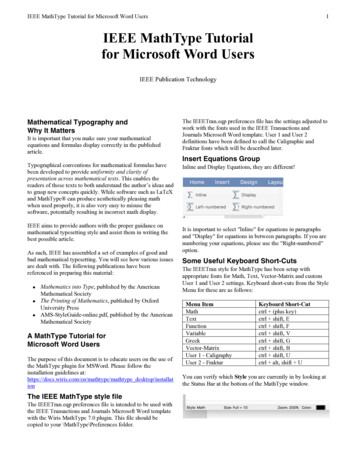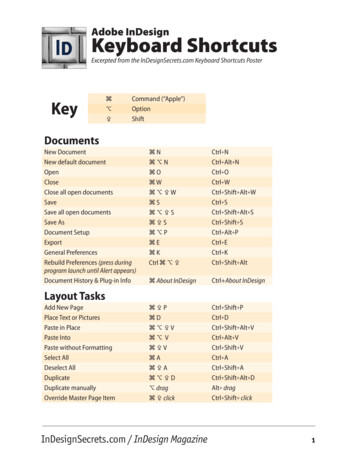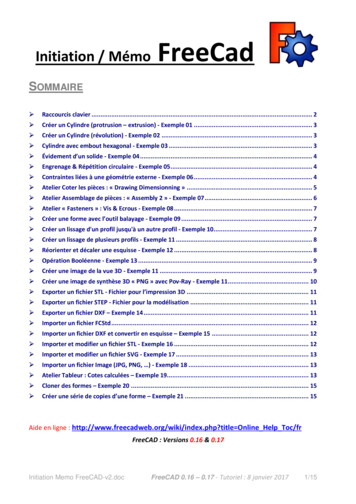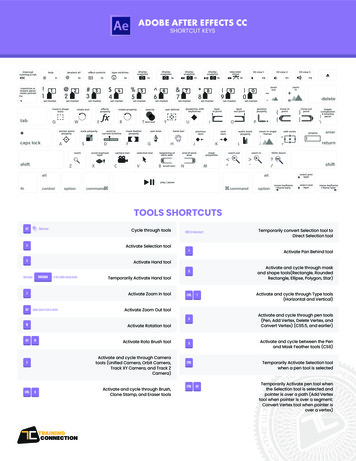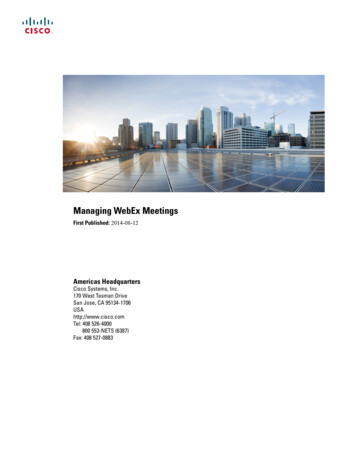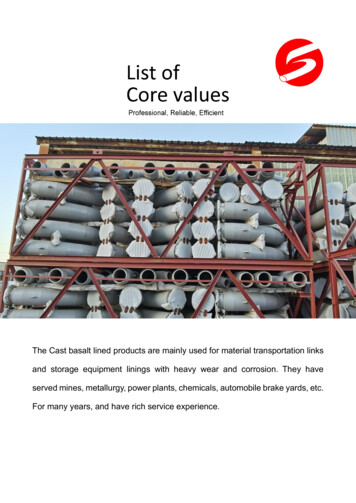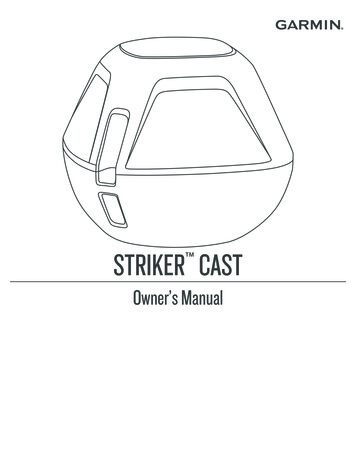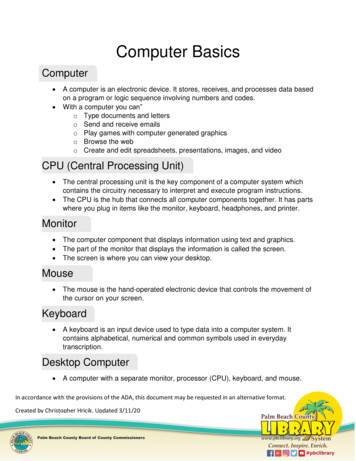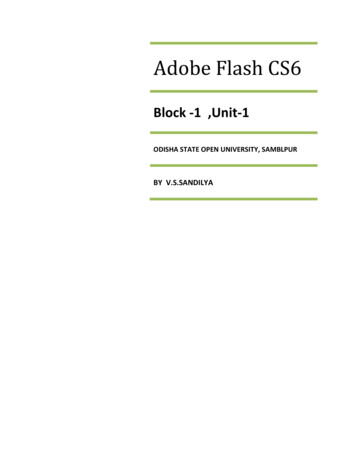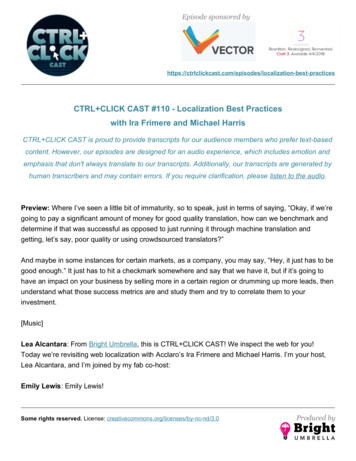
Transcription
Episode sponsored best-practicesCTRL CLICK CAST #110 - Localization Best Practiceswith Ira Frimere and Michael HarrisCTRL CLICK CAST is proud to provide transcripts for our audience members who prefer text-basedcontent. However, our episodes are designed for an audio experience, which includes emotion andemphasis that don't always translate to our transcripts. Additionally, our transcripts are generated byhuman transcribers and may contain errors. If you require clarification, please listen to the audio.Preview: Where I’ve seen a little bit of immaturity, so to speak, just in terms of saying, “Okay, if we’regoing to pay a significant amount of money for good quality translation, how can we benchmark anddetermine if that was successful as opposed to just running it through machine translation andgetting, let’s say, poor quality or using crowdsourced translators?”And maybe in some instances for certain markets, as a company, you may say, “Hey, it just has to begood enough.” It just has to hit a checkmark somewhere and say that we have it, but if it’s going tohave an impact on your business by selling more in a certain region or drumming up more leads, thenunderstand what those success metrics are and study them and try to correlate them to yourinvestment.[Music]Lea Alcantara: From Bright Umbrella, this is CTRL CLICK CAST! We inspect the web for you!Today we’re revisiting web localization with Acclaro’s Ira Frimere and Michael Harris. I’m your host,Lea Alcantara, and I’m joined by my fab co-host:Emily Lewis: Emily Lewis!Some rights reserved. License: creativecommons.org/licenses/by-nc-nd/3.0Produced by
Episode sponsored best-practicesLea Alcantara: Today’s episode is sponsored by Vector Media Group. Vector Media Group is a fullservice, interactive agency based in New York. They specialize in web and app design developmentand online marketing. In addition to custom platforms, Vector is widely known as a top Craft CMS andExpressionEngine partner and has done lots of work integrating Craft with single sign-on solutions. Get intouch today at vectormediagroup.com.This episode is also sponsored by Craft CMS. The release of Craft 3 is just a days away. Craft 3features the Craft plugin store where you can install plugins directly from the control panel, multi-siteand improved image editor and more. Craft 3 has been completely refactored and rewritten foroptimal performance so it’s fast. The Craft team has also recently launched Craft ID, a portal whereyou can purchase and manage all your Craft licenses and plugins. You can sign up for your Craft IDtoday at id.craftcms.com, and Craft 3 will be available on April 4 th at craftcms.com and on GitHub.Emily Lewis: It’s been nearly seven years since we talked about web localization and a lot haschanged, so we’re excited to have Ira Frimere and Michael Harris on the show to talk about today’sbest practices. Ira is the VP of Product at Acclaro and Michael is the Lead Solutions Engineer.Acclaro provides translation and localization services for everything from websites to software totraditional documents. Welcome to the show, Ira and Michael.Ira Frimere: Thank you for having us.Michael Harris: It’s great to be here.Lea Alcantara: Thank you. So can you tell our listeners more about yourself? Ira, let’s start with you.Ira Frimere: Sure. So I joined Acclaro just about two years ago. I’m based out of our New York officehere in Westchester, which is about 30 minutes north of the city and I have two young boys, so I amalways trying to make sure that they understand the translations of parenting at home.Some rights reserved. License: creativecommons.org/licenses/by-nc-nd/3.0Produced by
Episode sponsored best-practicesLea Alcantara: [Laughs]Emily Lewis: [Laughs]Ira Frimere: And I’m trying to work how folks understand each other across the different languages.Lea Alcantara: How about you, Michael?Michael Harris: Yeah, I work in our San Francisco office, and I’ve been in the translation industry forten years. I started out as a freelance. Well, I actually started out as an English teacher and then Ibecame a freelance translator and eventually I worked into the engineering area, and then I’ve beenworking with a lot of different kinds of companies here in California, with technology companies andmore traditional businesses.Emily Lewis: Fascinating. So I’m curious, Michael, it feels like a natural fit to go from like an Englishteacher to working in translating because it has so much to do with language and communication, buthow did you get into the engineering aspects?Michael Harris: My first job was for a company that did medical device, the pharmaceuticaltranslation, and those sectors tend to be kind of far behind, technologically speaking, so there were alot of things that just had to be figured out and I found that I was really good at kind of digging intothese obscure problems. There’s a lot of research and translation and I think that’s really where thetransfer came from, being able to dig through documentation and find answers to problems thatweren’t immediately obvious.Emily Lewis: Let’s start with the basics, what is localization? Is it is simply translating websites fordifferent languages, or is there more to it than that, Ira?Some rights reserved. License: creativecommons.org/licenses/by-nc-nd/3.0Produced by
Episode sponsored best-practicesIra Frimere: That’s a great question because I had the same exact thoughts, and it’s little bit differentthan Michael, I was completely new to localization, so I had no experience prior to joining Acclaro,and I think on my interview, the first question I asked our CEO was, “Why does anyone needs humantranslators? Can’t you just use Google Translate or Microsoft Translate?”Emily Lewis: [Agrees]Ira Frimere: And looking back on that question two years ago, I can’t believe I asked it, but I thinkalso many other folks like me who didn’t understand the nuances of localization and translation havethe same question. So I think what opened my eyes was trying to go to a website that wasprofessionally translated in a foreign language that I didn’t speak and then trying to translate it toEnglish and read that, and then you realize where the automated translation can help and where itreally can’t. So that’s where I learned it’s not about translating the words, but it’s about translating themessage and translating the intent and the context.Lea Alcantara: [Agrees]Ira Frimere: And so that was kind of the big wake-up call for me and then there’s a lot of differentsemantics between translation versus localization, but for me, the localization aspect then comes intoplay when you really need to change a message for cultural reasons.Lea Alcantara: [Agrees]Ira Frimere: So something that means one thing in the US might mean something else overseas, andthat’s where of the human translation benefits really come into play as well because you have tounderstand what make sense in different markets.Some rights reserved. License: creativecommons.org/licenses/by-nc-nd/3.0Produced by
Episode sponsored best-practicesLea Alcantara: So how about you, Michael, is there any development or nuances to localization thatpeople need to know?Michael Harris: Yeah, I think that there are a lot of details around making your app work in multiplelocales, so there are, say, like date format, how you show your decimal separators.Lea Alcantara: Right.Michael Harris: There are a lot of little things like that that are very different between countries, and Ithink a lot of people take them for granted. Currency format is another big one. Everyone writes thisdifferently, so you need to make sure that your application is ready to support a lot of different casesand things that you might consider to be very basic and you might just take for granted would workeverywhere.There are also, as Ira said, a lot of considerations around making sure that your content will beinterpreted the way you want it to be in your target market. Not every message is going to beunderstood the same way, and not all of your choices around things like tone will be received thesame way. We may, in America, like to have a very informal tone in some of our marketingcommunications, but that can off very badly in other cultures. So there is an adaptation aspect as wellthat’s very important.Emily Lewis: Is that the biggest misconception you think about localizing for the web, that it’s simplytranslating words as opposed to what you described, which is more about message and tone?Michael Harris: Yeah, I think the biggest misconception you actually see more has to do with thepeople. I think a lot of people do actually, on some level, understand those problems. I think themisconception that often comes about is that people think that simply having some proficiency inanother language or having a group of people who are willing to translate means that you have aSome rights reserved. License: creativecommons.org/licenses/by-nc-nd/3.0Produced by
Episode sponsored best-practicesqualified pool of translators. So I think there’s been a trend over the last ten years since Facebookhad their crowdsourcing effort to try and find ways to do community-driven localization orcrowdsourcing rather than using qualified professional translators.Emily Lewis: [Agrees]Michael Harris: And that does work in some cases, but we’re seeing increasingly that this hasbecome like a new stepping stone to your localization maturity, like companies are increasinglyhaving this period where they use crowdsourcing, inexperienced translators, and they end up withreally bad quality and then they have to find a way to work past that.Emily Lewis: [Agrees]Michael Harris: So I think that, yeah, there’s a tendency to disregard the value of a well-trainedprofessional translator.Ira Frimere: The other thing I would add that I’ve seen, too, is also for companies looking to translatetheir website is to make sure they have clear ROI business models in place to determine whether ornot investing in a language makes sense or not.Emily Lewis: Right.Ira Frimere: I think where I’ve seen a little bit of immaturity, so to speak, just in terms of saying,“Okay, if we’re going to pay a significant amount of money for good quality translation, how can webenchmark and determine if that was successful as opposed to just running it through machinetranslation and getting, let’s say, poor quality or using crowdsourced translators?” And maybe insome instances for certain markets, as a company, you may say, “Hey, it just has to be good enough.It just has to hit a checkmark somewhere and say that we have it.” But if it’s going to have an impactSome rights reserved. License: creativecommons.org/licenses/by-nc-nd/3.0Produced by
Episode sponsored best-practiceson your business by selling more in a certain region or drumming up more leads, then understandwhat those success metrics are and study them and try to correlate them to your investment.Lea Alcantara: [Agrees]Timestamp: 00:10:09Emily Lewis: So could you talk about that a little bit more because I’m not that familiar with it, butwhat you’re starting to talk about really rings familiar in terms of when we’re just talking to a clientabout what CMS they should invest in, and that we get to understand like what their business goalsare, what their staff like operations need to be.Lea Alcantara: [Agrees]Emily Lewis: So what that does look like when you’re working with an organization who wants toinvest in localization, but you need to tie it to goals? What are those conversations look like?Ira Frimere: Oh, I might go into more of the technical details, but again, being relatively new tolocalization, I was kind of floored with how many CMSs are out there. So obviously, you have theWordPress and the Drupals so that they have names, but then you have Kenticos and Joomlas andAdobe Experience Manager and a wonderful up and coming CMS in Craft, so there are just so manychoices. It is really difficult to figure out what the right solution is, and I think localization is not the onlycriteria you need to value, but it should be a really important one if you believe that at some point youwant to bring your website and your apps that are built on the CMS and you want to go global, thenknowing that that CMS is friendly for localization, to me is an important criteria that should go into themix.Some rights reserved. License: creativecommons.org/licenses/by-nc-nd/3.0Produced by
Episode sponsored best-practicesEmily Lewis: Oh, so when you’re talking to an organization that’s going to invest in localization,you’re not just talking about the translation itself and establishing what those benchmarks are, you’realso talking about software like a CMS, too.Ira Frimere: Yes, many times we do have prospects come to us and say, “Hey, we’re considering anew CMS. Do you have recommendations?”Emily Lewis: [Agrees]Ira Frimere: And many times, probably even more so, companies are coming to us with an existingCMS and then they’re just oftentimes trying to retrofit localization, so that’s why we sometimes learnthe hard way and had to work with enterprise customers trying to figure out how to export content andimport content to different languages, how to configure for the multilingual websites, how to set up theURL structures and different variables, and so through those lessons learned, any customers whocome to us and ask for the help on something, a new CMS, we know the right types of so gotchasand pointers to give them to help them with their overall selection.Lea Alcantara: So what are those gotchas, Michael? I think you probably would have the betterperspective.Michael Harris: Oh, I think the biggest gotcha is just selecting a CMS that doesn’t have any supporttranslation.Emily Lewis: [Agrees]Lea Alcantara: Right.Some rights reserved. License: creativecommons.org/licenses/by-nc-nd/3.0Produced by
Episode sponsored best-practicesMichael Harris: I’d say the best thing you want to see in a CMS is, in addition to just being able tosupport content in multiple languages, that it can actually export that content so that you can get it toa provider.Emily Lewis: [Agrees]Michael Harris: There’s a lot. I’m shocked actually at how many CMSs support some level oftranslation without having any way to get the content out and back in, and that’s really important justfor efficiency. If you’re working with a language service provider, there are a lot of tools that we usethat can ensure that your content is consistent, that your glossary terms and your intellectual propertyis being handled correctly, and all of that goes out the window if we’re not able to get the content outof the management system.Emily Lewis: [Agrees]Lea Alcantara: [Agrees]Michael Harris: So we find that some of the bigger systems, Drupal and WordPress, support thisvery well. Some systems, not so much, and we always will do a bit of digging to make sure that whatthey’re using or what we’re recommending isn’t going to lead to more work copy pasting or having todo crazy work around.Emily Lewis: [Agrees]Lea Alcantara: Right.Michael Harris: Yeah.Some rights reserved. License: creativecommons.org/licenses/by-nc-nd/3.0Produced by
Episode sponsored best-practicesIra Frimere: Yeah, so our philosophy to help our clients in the most efficient manner is saying, “Well,if you’re working in your CMS on a daily basis, isn’t that the place where you want to ordertranslations from and review initial draft translations we provide to you, get feedback and then receivethe final translations and quickly publish,” and that’s pretty straightforward. That’s something that allof our website translation customers want to do.Emily Lewis: [Agrees]Ira Frimere: And so like Mike said, some of the bigger CMSs like WordPress and Drupal have beenfortunate enough to have some sophisticated really nice plugins; WPML for WordPress, TMGMT forDrupal, that have enabled growing on top of the native functionality in the CMS to make it even moreeasier for multilingual, especially when it comes to involving professional human translators in themost efficient way, as Mike said, so that we can use our tools.Emily Lewis: [Agrees]Ira Frimere: And it really is all about getting that content out and then getting the translated contentback in in the most seamless fashion that allows language service providers like ourselves or evenfreelance translators with a way, a safe way, that we can essentially do the translations more withouthaving to be logged into your CMS’s back end, or log into a customer’s CMS’s back end and doing abunch of inefficient copy paste.Emily Lewis: Yeah. That was what I was just about to ask you, if what you were describing was thatyou had to log into their CMS and work with that, so you’re working with your tools most efficientlyand then the clients hopefully has a CMS that can import and export easily that content from yourtools so that they use their tools that they’re efficient with. Is that right?Some rights reserved. License: creativecommons.org/licenses/by-nc-nd/3.0Produced by
Episode sponsored best-practicesMichael Harris: Yeah, and I think something that’s really, really interesting about this is that fromwhere we are, if the client gets into this position where they need to be copy pasting, that problemdoesn’t usually end up falling on us. Usually, it’s the client who is the one who ends up having to doall of the copying and pasting.Emily Lewis: [Agrees]Lea Alcantara: [Agrees]Michael Harris: So I think it’s even that much more important if you’re in a case where you can’t pushit off your position under.Emily Lewis: [Agrees]Lea Alcantara: [Laughs]Ira Frimere: Yeah, and the plugins have matured to a point so the vision is definitely you’re anenterprise customer, you’ve installed the multilingual plugin, you’d connect via the Acclaro or for us,our Translation Service Provider’s API or connected to the plugin, and then you as a customer justselect content, send to us, tell us what languages you need to translated in, we do the translation,send it back to you, and we never have to log into your CMS, and that’s the vision.Emily Lewis: That’s nice.Ira Frimere: But to be entirely honest, yeah, we’re not there yet as an industry.Lea Alcantara: Right.Some rights reserved. License: creativecommons.org/licenses/by-nc-nd/3.0Produced by
Episode sponsored best-practicesIra Frimere: Just because all the CMSs are so completely unique from each other, especially with theextreme plethora of third-party added plugins that create additional kind of complexities.Emily Lewis: Complications.Ira Frimere: Yeah, right.Emily Lewis: [Agrees]Ira Frimere: So if you’re using a certain plugin that has a form, well, how do you get that text in thatform translated in an easy way? But the vision is definitely there, and we are getting closer. What wefind is oftentimes with newer customers, we might need to log in with them to a staging site in thebeginning and then once we get everything set up, then we’re really not logging in at all and then wecan get that initial vision into a reality. It’s not a plug and play and power and start.Emily Lewis: And I know, Ira, you mentioned that you are, at least compared to Michael, a little bitnewer to the industry, but from your perspective, especially involved with the product direction, do youfeel like that vision that you’re describing where we’re not quite there, but the vision is there. Is that’swhat’s really changed about localization over the years, that there’s now kind of cohesive idea of thedirection that that the technology needs to go. Whereas it feels like when we talked about it before, Idon’t think we even discussed this concept of the workflow between the translation service and theorganization that needs the localization and it really was just cutting and pasting and working verymanually.Ira Frimere: I mean, I think even in just the two years that I’ve been involved, I have seen its activedevelopment in those creating plugins and connectors for the LSPs (Language Service Providers), soI think the LSP industry is pushing very hard, realizing that if we want to continue to get business intranslating websites, we need to make it easier for enterprise customers to do so, and if it’s a realSome rights reserved. License: creativecommons.org/licenses/by-nc-nd/3.0Produced by
Episode sponsored best-practicesheadache for them, they’re just going to try to figure out whatever is the easiest path that may notinclude LSPs. So I’m definitely seeing a push from the LSPs. I’m also seeing a push from the CMSvendors as well because for the larger enterprise customers that are going to pay more for thewebsite development and the CMS maintenance and the CMS features, they are going to be lookingfor localization capabilities as well. So I’ve definitely seen some improvements over that past twoyears and I’m excited about the continuing improvements that will be coming.Emily Lewis: You know, I want to ask Michael about the development evolution, but I’m curious, Ira,if you could touch on it. Do you see any changes with especially like enterprise organizations wantingmore localization than they have in the past? Is there a business need that’s driving this?Ira Frimere: Let us backtrack. I think what we’ve talked about earlier, which is some enterprises haveto go, let’s say, global for legal reasons, and then the other enterprises, it’s about understanding theiropportunity costs and opportunity potential in going to those different markets.Emily Lewis: [Agrees]Ira Frimere: What I’ve seen with some of our customers who may be starting with one or twolanguages, when they realized working with an LSP such as ourselves, we’re not about translatingyour words on your website in the different regions, but we’re about helping you be successful in adifferent market that you choose to operate with all of your content.Emily Lewis: [Agrees]Timestamp: 00:20:13Ira Frimere: I think when they realize, yeah, it’s more expensive than if I just found a freelancetranslator on the web somewhere or tried to get volunteers in my company across different markets toSome rights reserved. License: creativecommons.org/licenses/by-nc-nd/3.0Produced by
Episode sponsored best-practicestranslate, there is added cost in dealing with a professional LSP, but when we kind of remove theheadache through them of having to manage it and we can show them how quickly they can A/B testin different markets to determine what messaging works, then I think we have seen some increasedbusiness from that, and it’s really about creating a hybrid also where we’re not viewing machinetranslation as the enemy of our business, but we’re viewing it as a productivity enhancement.Emily Lewis: [Agrees]Lea Alcantara: [Agrees]Ira Frimere: So it’s not really humans versus machines, but it’s humans empowered with machinesso that allows us to do things better and faster and more efficiently.Michael Harris: Yeah, and just talking about the volume of people looking for more translation, I thinkwhat’s really happening over the last ten years or so is that the amount of content that come to me,that we are producing that could be translated has really gone up, particularly contents that’s beingproduced by user or knowledge-based content, things like that. So services like machine translation, Ithink where we are right now, kind of to what Ira said, they’re not exactly replacing the human side,but they’re making it possible to process a lot more of that content because if you were to handle allof your user-generated content or all of your knowledge base at the same price point that you do usefor your core documentation, you could just never afford to do it.Emily Lewis: Yeah, you’re right.Michael Harris: So the machine translation gives you a way to do a good enough job and get more ofthat content out there maybe at a lower, but still acceptable level of quality.Some rights reserved. License: creativecommons.org/licenses/by-nc-nd/3.0Produced by
Episode sponsored best-practicesLea Alcantara: So I’m just curious about how that balance between machine-generated content andhuman-curated content is met when you’re trying to develop for a site, like is this more really aworkflow situation or is there a development solution?Michael Harris: Well, when I started in the industry, I’d say that localization still is you had the feelinga lot of times that it was an afterthought, that the application hadn’t been planned with localization inmind and there was going to be a lot technical debt that had to be cleared to do it.Lea Alcantara: [Agrees]Michael Harris: With all of the advances we’ve had, particularly in open source software, over thelast ten years, I think that the development aspects of localization have become much clearer andmuch better defined. All of the major frameworks that we see commonly used now actually supportinternationalization and localization database. So if you’re working with Node or Rails or Django, anyof those frameworks have built-in localization functionalities that work really, really well. So I think thatsome of the development aspects of localization have gotten a lot simpler in your kind of standardweb apps and things like that.Lea Alcantara: [Agrees]Michael Harris: The question of what the mix of human to machine translation should be is reallymore I think a business problem.Emily Lewis: [Agrees]Lea Alcantara: Okay.Some rights reserved. License: creativecommons.org/licenses/by-nc-nd/3.0Produced by
Episode sponsored best-practicesMichael Harris: So you’re going to want to use high-quality human translation for your softwareobviously, like you want to make sure that you have a translator who understands what your softwareis doing and what it looks like on the screen and what really needs to be communicated to the user.The documentation as well is generally going to need a human translator, but when you start gettinginto things like knowledge-based articles or maybe if you’re producing a lot of blog posts or things likethat, you may want to triage that content and say, “You know, here we have a question that wasasked in this market, and this looks like it will be really useful in other markets even if it hasn’t comeup yet, so how do we make sure that that’s available?”And generally, a lot of the contents that you end up looking at from machine translation might not bein the core application. It’s more likely to be in something like ZenDesk or your Jira service desk orwhatever you’re using to collect that information from your user. So it’s a little bit different from justthe normal development question.Ira Frimere: I would just add to that, I think for our customers who do have mature processes in placeto understand the success of their content, how much is being read, how long folks are on sites for,they can always order additional enhancements.So for instance, if you have a blog post and you want to try it out in fifteen different languages, maybethe top five most spoken languages, you want to immediately pay for human translation, but for theother ten, you can just do some machine translation, and ideally you’ll use, let’s say, customizedengine, your language service provider would manage this so it would be better than what comes outof just the native web because it will have your consistent terms and guidelines, but it will be reallyinexpensive to roll out, and then if you’re measuring the readership, you can just say like, “Hey,maybe in this market we’re getting high volume of clicks, but then people are just dropping rightaway.” So you know you have, let’s us say, a catchy headline, but the content isn’t well written, sowhat you can do is just turn a lever and up the quality.Some rights reserved. License: creativecommons.org/licenses/by-nc-nd/3.0Produced by
Episode sponsored best-practicesEmily Lewis: [Agrees]Ira Frimere: So maybe there are some opportunities there again that would leverage the gist of whatthe machine can put out with a quick turnaround to enhance based upon readership of.Emily Lewis: So Ira, you had mentioned right there using a machine that has been customized foryour own terms and phrases, can you describe that a little bit more? That’s totally different thansomething like just dropping in like a Google Translate plugin, right?Ira Frimere: Exactly. You know, Mike will be able to better explain all the terms here, but from a highlevel business perspective, when you’re working with a language service provider such as us, westore what’s called translation memory, and what that is, it’s everything we’ve ever translated for you,we keep in a database across the different languages.Emily Lewis: Oh.Ira Frimere: Also, in that memory, we keep track of your glossary and style guidelines. So for, let’ssay, you’re going into five different languages and you’ll say, “So these five languages, these are thespecific terms I always want to be translated this way.”So we keep track of all that information in this high-level translation memory and you can use thosememories to train machine translatio
best practices. Ira is the VP of Product at Acclaro and Michael is the Lead Solutions Engineer. Acclaro provides translation and localization services for everything from websites to software to traditional documents. Welcome to the show, Ira and Michael. Ira Frimere: Thank you for having us. Michael Harris: It's great to be here.
